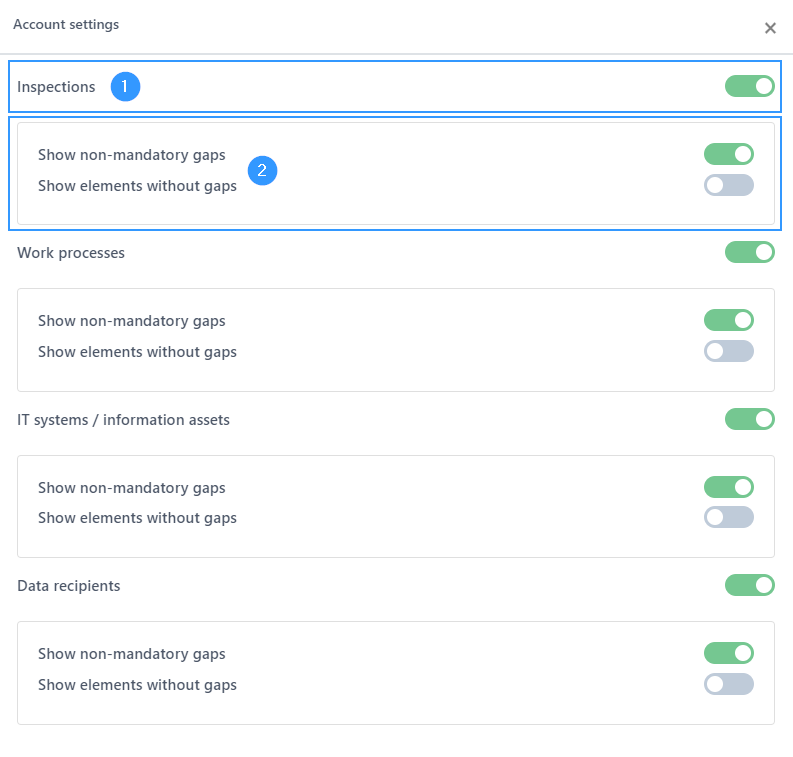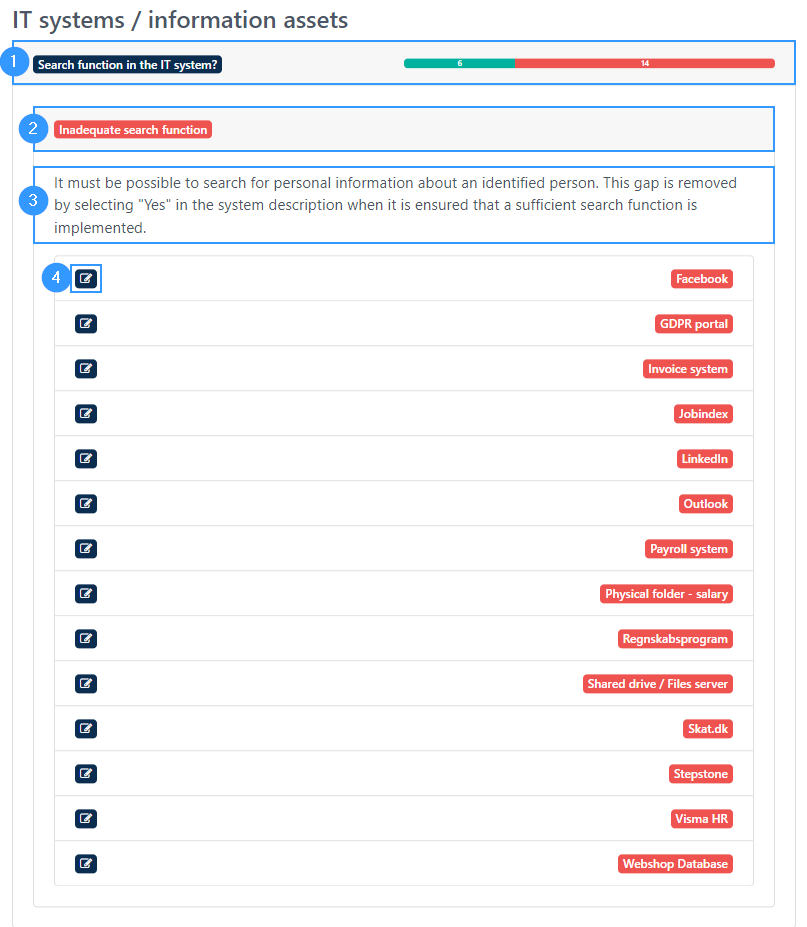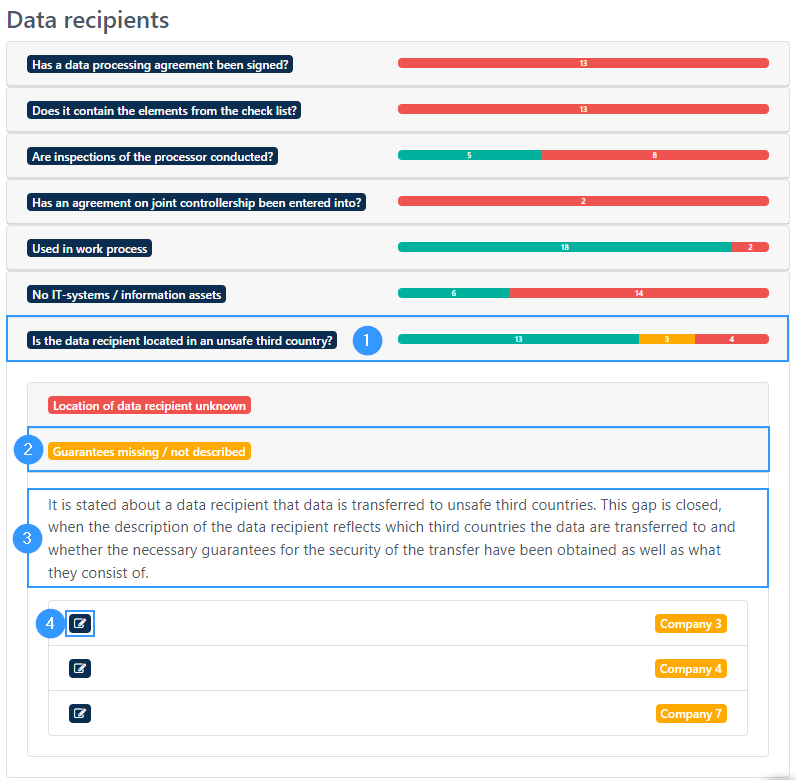Dashboard
The Dashboard is an overview of the different elements in the portal. The dashboard can be used as a to do list of what needs to be done in order to be compliant, as it gives an overview of gaps and other missing parts such as missing information or overdue inspections, that needs to be handled before the goal of being compliant is achieved.
How to use the Dashboard
The dashboard is the page, that the portal opens directly when loggin on to the portal. Otherwise the dashboard can be found in the top of the menu bar to the left.
A Dashboard can look like this:
- Settings: By clicking here, you can edit what information is in your dashboard. Here you can set the following areas: Inspections, Work processes, IT systems / information assets and Data recipients. Next to each area, you can choose whether the dashboard should show non-statutory gaps and whether it should display elements without gaps.
The four areas shown in the dashboard will be briefly described below, and further down the page you will be able to find a more in-depth explanation of the use and significance of the individual areas. - Inspections: This is the overview of inspections. For more insight, you can click on the bars in the box where they will unfold.
- Work processes: This is the overview of work processes that is divided into different elements of a work process. Based on each item, you can click to unfold more detailed information. Here you can find out which and how many work processes contain gaps, which in this relation is an expression of informational deficiencies..
- IT systems / information assets: This overview, like work processes, is divided into different elements of the IT system / information asset. Based on each element, you can see the status of the individual element and orient yourself in which elements are filled in and which contain gaps, which in this relation is an expression of informational deficiencies.
- Data recipients: This is the overview of data recipients which is divided into different elements of a data recipient. Based on each item, you can click to unfold more detailed information. Here you can find out which and how many data recipients contain gaps, which in this relation is an expression of informational deficiencies.
Further about settings
When you click on the icon in the image above (1) you will open the following window:
This is where you can choose what should appear on the dashboard. Settings are divided into the four different main points; inspections, work processes, IT systems/information assets and data receivers.
You can choose whether you want to see overviews of the four main points by clicking them on or off on the green icon next to the single item (1).
In addition, you can choose which information you will be able to gain closer insight into from your overview. (2) This setting will not affect the overview bars with colors but will affect what closer insight you can get into the different elements from the dashboard.
In the reviewed below, the dashboard is set as shown in the image above.
The different areas of the dashboard
Inspections
If the top bar below inspections shows a red color, it indicates that some inspections have been exceeded. You can get more insight in which inspections are overdue by clicking on the “overdue” bar. This will cause the bar to open an overview of all exceeded inspections. In the overview, you can see both the individual inspection and who is responsible for the inspection.
Here it is possible to click on the individual inspection (1) and then on the folder icon (2). This will open the following window:
- Information about the individual inspections
- By clicking here, you can see an overview of which employees that are responsible for the inspection.
- Here you can send out reminders to employees to complete the inspections. It is also possible to send reminders by clicking on employees in section 2 and choosing which employees the reminder should be sent out to.
- By clicking here, you will be able to attach files.
If the yellow color appears in the top bar, it indicates that there are some ongoing inspections. You can find out about these by clicking on the “ongoing” bar which will show an overview of all ongoing inspections. You can see the name and responsible for the inspection and get more information about the ongoing inspection by clicking on the individual inspection as in the above example for overdue inspections. It is also possible in the same way to send out reminders.
When the bar reflects a green color, it indicates that an inspection has been completed.
If there are some blue fields below the bars “exceeded” and “ongoing”, it is an expression of an informational purpose that is not necessarily a problem but that something is missing in the setup of the inspection. The title of the blue boxes will explain how they are grouped. In this example, there are some inspections where the notifications are inactive. By clicking on the field, you will get a detailed overview of which inspections, and there will be a small brief description of the meaning of the defective setup.
Work processes
The overview of work processes is divided into the different elements that belong to a work process. The items are consistent with the fields that must be filled in when creating a work process.
- You can click on each bar and get details of the fields that aren’t green and therefore require a decision.
- For each point, you will be able to see a bar that can show red, yellow, green, and blue.
The green fields in the bars indicate that the fields are filled in in accordance with the requirements of the legislation for work processes.
The red is an expression of a gap, which means that there is a gap in connection with the work process in order for it to be in accordance with the legislation in the area. This gap deals with key pieces of information that need to be filled. A red gap in connection with work processes cannot be accepted and requires this to be considered by filling out the work process with the information required.
You can get a closer insight and direct access to the individual work processes by clicking on the individual bar (1), where you want to get more information about which work processes contain the mentioned gaps. When you click on the bar, subbars will open. There will be a description of why there is a gap – in this example, the obligation to fill in information is not fulfilled (2). You can click on this field and get a closer insight into which work processes are involved. In the overview of the work processes, you can click directly into the individual work process by clicking on the icon on the left (3). Inside the form for the work process itself, there will be a red exclamation mark next to the field – be aware that there may be more than one red exclamation marks if each work process contains multiple gaps.
A yellow color in the bar also means that there is a gap in the work process, which must be filled for the work process to comply with the legislation. When a gap appears yellow in relation to work processes, it indicates a lack of detail. To understand the difference between yellow and red gaps, the legal basis to be filled in during the work process can be used. If the legal basis is not filled in, it is a key information that is missing and thus a red gap. If there is no justification for the legal basis, it is the level of detail that is insufficient and thus a yellow gap. In relation to work processes, both red and yellow gaps require that the necessary information is created in the work process. In the dashboard, the yellow gap features will work similarly to red, but in the work process, you’ll see them as yellow exclamation marks next to the elements that are causing the gap.
When a bar shows a blue color, it is something to be aware of, but not necessarily a problem in relation to the work process and whether it meets the regulatory requirements. It can be understood as having an informational function. In the example below, you can see that the blue field indicates that an update of legal basis has been made (1) and by clicking on it, a bar unfolds where there is an explanation of why the individual work process is marked in blue (2) and the opportunity to click directly into the work processes that invovled (3)
In addition to being information about a change in the portal that may have an impact on the individual work process, it may also be information that needs to be entered, but which does not necessarily pose a problem in relation to preparing a work process in accordance with the legislation.
IT systems / information assets
The overview of IT systems / information assets is divided into the various elements that belong to an IT system / information asset. The points are consistent with the fields to be filled in when creating an IT system / information asset.
- You can click on each bar and get details of the fields that are not green and therefore require a decision.
- For each point, you will be able to see a bar that can show red, yellow, green, and blue.
The green fields in the bars indicate that the fields are filled in in accordance with the requirements set by the legislation for IT systems / information assets.
The red and yellow boxes are expressions of gaps and have the same meaning as mentioned under work processes and are thus elements where information must be provided to comply with the legislation.
You can get more information about the individual elements by clicking on a desired item (1).
Below, the gap will appear marked in red (2) and clicking here opens a closer insight into the individual gap. There will be a justification of the gap and an explanation of how it is removed (3). Furthermore, it is possible to access the form for an IT system / information asset directly by clicking on the small icon to the left of the specific IT system / information asset (4).
Data recipients
The overview of data recipients is divided into the different elements relating to data recipients. The points are consistent with the fields that must be filled in when creating a data receiver.
- You can click on each bar and get details of the fields that are not green and therefore require a decision.
- For each point, you will be able to see a bar that can show red, yellow, green, and blue.
The green fields in the bars indicate that the fields are filled in in accordance with the requirements set by the legislation for data recipients.
The red and yellow boxes are expressions of gaps and have the same meaning as mentioned under work processes and are thus elements where information must be provided to comply with the legislation.
You can get more information about the individual elements by clicking on a desired item (1)
Below, the gap will appear marked in yellow (2), and clicking here opens a closer insight into the individual gap. There will be a justification of the gap and an explanation of how it is removed (3). Furthermore, it is possible to access the form for a data recipient directly by clicking on the small icon to the left of the specific data recipient (4).
Address
GapSolutions A/S
Uraniavej 6, 1.
DK-8700 Horsens
CVR
CVR-nr. 38582356
Phone
Sales & administration
(+45) 8844 0808
Helpline & consultants
(+45) 2199 0808
Cookiepolicy
Privacy policy











